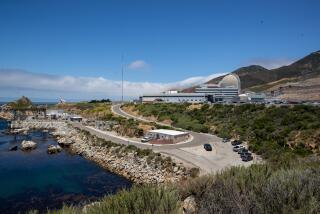License Refused for Seabrook Atom Plant
- Share via
WASHINGTON — The Nuclear Regulatory Commission voted Thursday not to issue a low-power license for New Hampshire’s Seabrook nuclear power plant.
Commission Chairman Lando W. Zech Jr. said evacuation plans that Seabrook owners submitted for Massachusetts communities within Seabrook’s 10-mile emergency planning zone were inadequate.
Massachusetts Gov. Michael S. Dukakis refused to submit the plans, so plant owners submitted their own.
“The plan itself was simply deficient. It was not a bona fide plan,” Zech said after the 3-2 vote. “As far as I’m concerned, it simply does not meet our standards.”
Beleaguered Reactor
Granting of the low-power license would have been a major step toward bringing the beleaguered reactor into full operation. It would have allowed the reactor to operate at 5% of power.
In January, the NRC voted to stay Seabrook’s request for a low-power license, saying that a full evacuation plan for the emergency planning zone should be on file with federal regulators before the license was issued.
Dukakis, whose state falls within the emergency evacuation zone, refused to submit plans for the six northeastern Massachusetts communities, saying the coastal towns could not be safely evacuated in the case of an emergency.
But the plant operator, New Hampshire Yankee, filed its own plans based on blueprints that Massachusetts officials had drawn up but then decided were inadequate to protect the beach-front population.
Licensing Opposed
Seabrook opponents have fought the low-power license, claiming that once Seabrook begins producing electricity through the nuclear process, any chance of converting it to other energy uses in the future would be eliminated.
“If the utilities really believe that we need the power, Seabrook’s only potential is as a conventionally powered plant,” said Paul McEachern, lawyer for the town of Hampton, N.H., which is fighting the plant. “Their headlong rush to low-power (licensing) doesn’t serve any purpose.”
New Hampshire Gov. John H. Sununu, a leading Seabrook proponent, submitted evacuation plans for his state.
But last week, the Federal Emergency Management Agency said in an advisory report to the NRC that his plans for the 17 New Hampshire communities around the plant would not adequately protect the population.
Plant officials dismissed the report as outdated and said any obstacle it represented would be overcome.
Adequacy of Plans
Regulators would still have to check the adequacy of the emergency plans before the plant could receive a full-power license.
The NRC is considering a rule change that would allow the regulators to issue a full-power license without local government participation in the evacuation plans.
Rep. Edward J. Markey (D-Mass.) and other congressional opponents of Seabrook are taking steps in Congress to exempt Seabrook if the rule is changed.
Seabrook, a 1,150-megawatt reactor under construction for more than a decade and approaching $5 billion in cost, has been finished for nearly a year. Seabrook II, a partly built sister unit, was scrapped last year because of financing problems.
The plant, owned by a dozen New England utilities led by Public Service Co. of New Hampshire, is about 40 miles from Boston on the southern New Hampshire coast.
More to Read
Sign up for Essential California
The most important California stories and recommendations in your inbox every morning.
You may occasionally receive promotional content from the Los Angeles Times.













